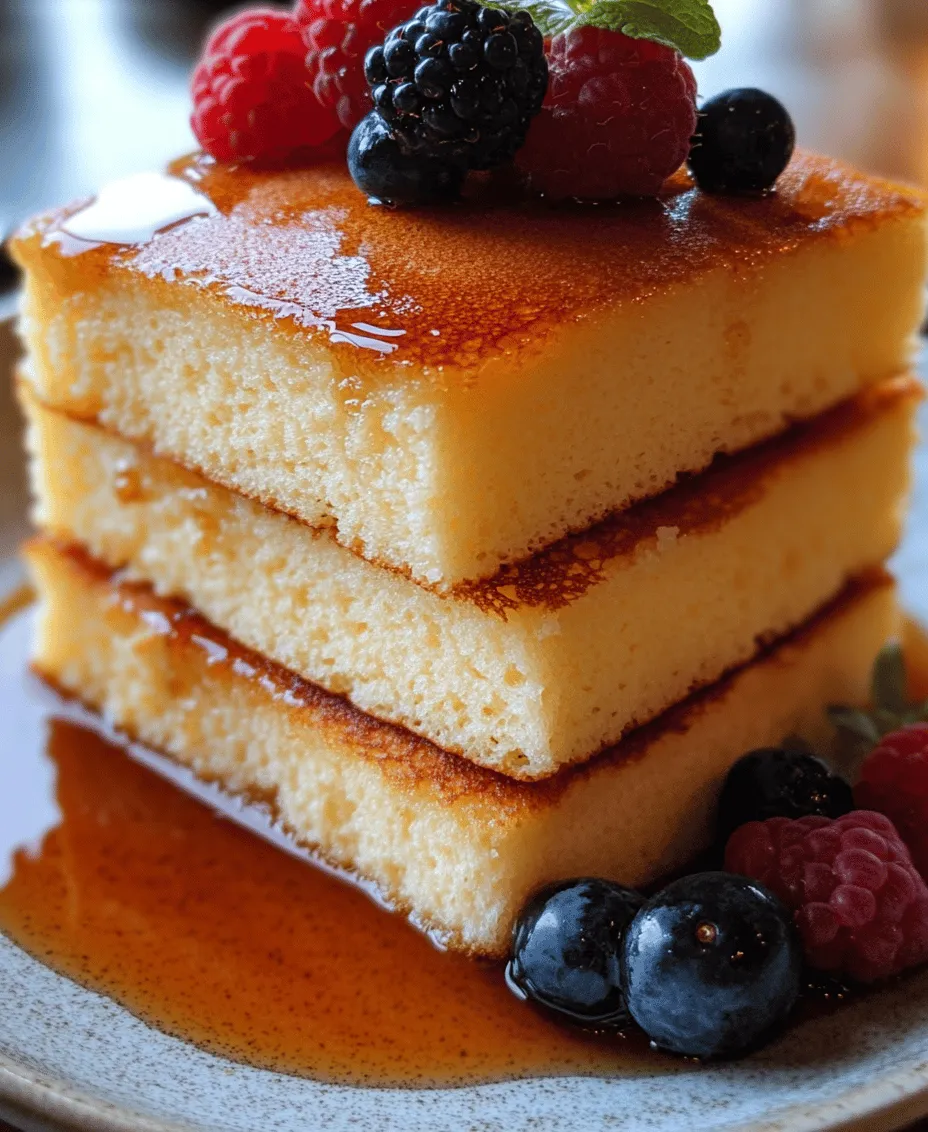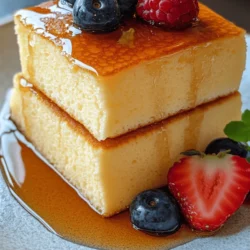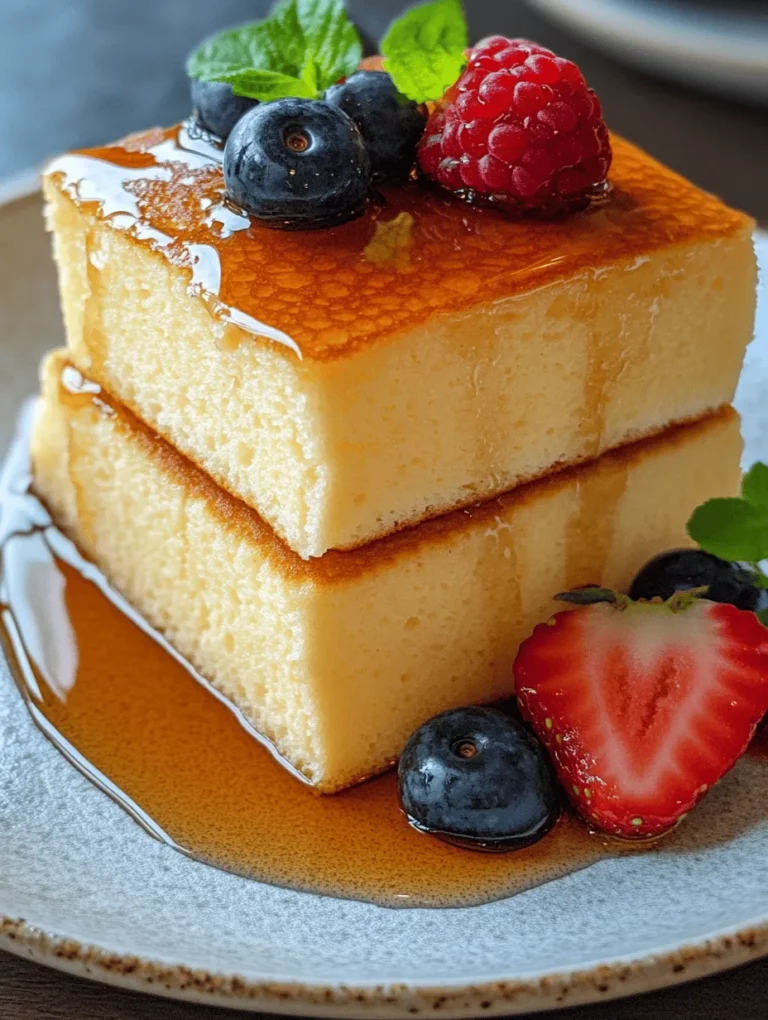Introduction
In recent years, fluffy Japanese pancakes have taken the culinary world by storm, captivating the hearts and taste buds of food enthusiasts globally. These pancakes stand out not only for their stunning appearance but also for their incredibly airy and light texture, which is a far cry from the denser, traditional pancakes most people are accustomed to. What sets these Japanese delights apart is their unique preparation method and the specific ingredients that contribute to their cloud-like fluffiness.
Japanese pancakes are often served in tall, thick stacks, and their soft, pillowy texture makes them feel like biting into a cloud. The fluffy quality is achieved through a combination of whipped egg whites and the right balance of ingredients, making these pancakes a true breakfast masterpiece. In this article, we’ll dive into the history and cultural significance of Japanese pancakes, explore the essential ingredients that make them so special, and guide you through the initial steps of creating your own batch.
Understanding Japanese Pancakes
Historical Context: Origins of Japanese Pancakes
The origins of Japanese pancakes can be traced back to the popular soufflé pancakes that emerged in Japan in the early 2000s. Inspired by the French soufflé, these pancakes quickly gained popularity in cafés and restaurants, leading to their rise as a beloved brunch item. They are often associated with the modern Japanese café culture, where aesthetics and taste go hand in hand.
Over time, the concept of fluffy pancakes has evolved, with various adaptations appearing across different regions. However, the quintessential Japanese pancake retains its focus on simplicity and lightness, highlighting the skillful technique involved in their creation.
Cultural Significance: Pancakes in Japanese Cuisine and Modern Adaptations
In Japan, pancakes are not merely a breakfast item; they are a versatile dish that can be enjoyed at any time of the day. Traditionally, pancakes may be served with sweet toppings such as syrup, whipped cream, or fresh fruits. However, contemporary variations have also introduced savory options, incorporating ingredients like bacon, cheese, or even vegetables.
The rise of social media has played a significant role in popularizing Japanese pancakes outside of Japan. Their Instagram-worthy appearance, often served stacked high and topped with colorful fruits and syrups, has made them a favorite for food bloggers and influencers. This visual appeal has contributed to a growing trend of Japanese pancake cafés popping up in major cities worldwide.
Comparison with Traditional Pancakes: Texture, Taste, and Presentation
When comparing fluffy Japanese pancakes to traditional pancakes, the differences are striking. Traditional pancakes are typically flat, dense, and often served in a large, round format. In contrast, Japanese pancakes are thick, soft, and voluminous, resembling a soufflé more than a pancake. The key to their unique texture lies in the incorporation of air through whipped egg whites, which create a light and airy batter.
In terms of taste, Japanese pancakes are subtly sweet, allowing the natural flavors of the ingredients to shine through. They are often enjoyed with a variety of toppings, which can include syrup, fresh fruit, whipped cream, or even matcha for a unique twist. The presentation of Japanese pancakes is also noteworthy; they are usually served in a tall stack, garnished artfully to enhance their visual appeal.
Essential Ingredients for Fluffy Japanese Pancakes
Creating the perfect fluffy Japanese pancakes starts with understanding the essential ingredients and their roles. Here’s a detailed breakdown of what you will need:
1. All-Purpose Flour
All-purpose flour serves as the foundation for the pancake batter, providing the necessary structure. It’s essential for creating a balance between fluffiness and firmness, ensuring that the pancakes hold their shape while remaining tender.
2. Cornstarch
Cornstarch plays a crucial role in achieving the fluffiness that makes these pancakes so delightful. By replacing a portion of the flour with cornstarch, you create a lighter texture, allowing the pancakes to rise more effectively during cooking.
3. Baking Powder
Baking powder is a leavening agent that contributes to the rise of the pancakes. When combined with the wet ingredients, it reacts to create carbon dioxide bubbles, which help lift the batter and create an airy texture.
4. Granulated Sugar
Granulated sugar adds sweetness to the pancakes and helps retain moisture, contributing to their soft texture. It also enhances the overall flavor, making each bite deliciously satisfying.
5. Salt
Though it may seem counterintuitive, salt is vital in balancing flavors and enhancing the sweetness of the pancakes. A small amount can elevate the taste and bring out the natural flavors of the other ingredients.
6. Milk
Milk serves as the liquid component of the batter, providing moisture and helping to dissolve the dry ingredients. It also contributes to the overall richness of the pancakes.
7. Eggs
Eggs are a key ingredient in pancake recipes, but for fluffy Japanese pancakes, the separation of the egg whites and yolks is particularly important. The yolks add richness and flavor, while the whipped egg whites are crucial for aeration, giving the pancakes their signature texture.
8. Vanilla Extract
Vanilla extract enhances the flavor profile of the pancakes, adding a subtle sweetness and depth that pairs beautifully with the other ingredients.
9. Unsalted Butter
Unsalted butter not only adds richness and moisture to the batter but also contributes to the overall flavor. It’s important to use unsalted butter to control the salt levels in your pancakes.
10. Cooking Spray/Butter
To ensure your pancakes cook evenly without sticking, you’ll need a non-stick cooking spray or a bit of butter. This step is essential for achieving a perfect golden-brown exterior.
11. Optional Toppings
While Japanese pancakes are delicious on their own, the right toppings can elevate the dish even further. Consider serving them with fresh fruits like strawberries or blueberries, a drizzle of maple syrup, whipped cream, or even a dusting of powdered sugar. For a unique twist, try adding matcha powder or a fruit compote for added flavor.
Step-by-Step Guide to Making Fluffy Japanese Pancakes
Preparing the Batter
The first step in making fluffy Japanese pancakes is to prepare the batter correctly. This involves mixing the dry and wet ingredients separately to ensure an even consistency. Start by sifting the all-purpose flour and cornstarch together with the baking powder, salt, and sugar. This not only combines the ingredients but also aerates them, which is essential for achieving a light texture.
Next, in a separate bowl, whisk together the egg yolks, milk, vanilla extract, and melted unsalted butter. It’s important to mix these ingredients thoroughly to create a smooth, homogeneous mixture. Once combined, carefully add the wet ingredients to the dry ingredients, stirring gently until just combined. Avoid overmixing, as this can lead to dense pancakes rather than the desired fluffy texture.
Whipping the Egg Whites
The next crucial step is whipping the egg whites to achieve stiff peaks. This process is vital for adding air to the batter, which is what makes these pancakes so light and fluffy. Use a clean mixing bowl and ensure your whisk or mixer attachments are free from any grease or residue, as this can affect the egg whites’ ability to whip properly.
Begin by whisking the egg whites on medium speed until they start to foam. Once they reach a foamy consistency, gradually add in a small amount of granulated sugar, increasing the speed to high. Continue whisking until the mixture forms stiff peaks, which should stand upright when the whisk is removed. This process can take a few minutes, so be patient and watch closely for the right consistency.
Once your egg whites reach stiff peaks, gently fold them into the prepared batter. Use a spatula to carefully incorporate the egg whites, being cautious not to deflate the mixture. The goal is to maintain as much air as possible, which is key to achieving those fluffy pancakes.
Cooking the Pancakes
With your batter prepared and whipped egg whites folded in, it’s time to cook the pancakes. Preheat a non-stick skillet or griddle over low heat and lightly grease it with cooking spray or butter. Using a large spoon or a ladle, pour a generous amount of batter onto the skillet.
To create those signature tall stacks, use a ring mold if you have one. This will help maintain the shape of the pancakes while they cook. Cover the pancakes with a lid to trap steam, which will further aid in cooking and achieving a fluffy texture. Allow the pancakes to cook for about 4-5 minutes on one side before gently flipping them. Be cautious not to rush this step; low and slow is the key to perfectly fluffy pancakes.
Continue cooking for an additional 4-5 minutes on the other side until they are golden brown and cooked through. Once ready, remove the pancakes from the skillet and repeat the process with the remaining batter.
—
The journey to mastering fluffy Japanese pancakes is filled with exciting techniques and flavors. With the right ingredients and careful preparation, you can create a delightful breakfast treat that will impress anyone who tries them. As you continue cooking, remember that practice makes perfect; each batch will teach you something new about achieving that ideal fluffy texture.

Folding Egg Whites into the Batter
Folding egg whites into the batter is a delicate but crucial step in achieving the signature fluffiness of Japanese pancakes. To start, ensure that your whipped egg whites are at the right consistency—stiff peaks that hold their shape when lifted. This indicates that enough air has been incorporated to help the pancakes rise beautifully.
Techniques for Gentle Folding to Maintain Volume
When folding, use a large spatula and employ a gentle motion. Start by adding a small amount of the whipped egg whites into the batter, which helps to lighten it. Then, using a sweeping motion, fold the batter over the egg whites, rotating the bowl as you go. Be cautious not to stir; you want to maintain the air bubbles that contribute to the pancakes’ light texture. Repeat this process until most of the egg whites are incorporated, but don’t worry if a few streaks remain—overmixing will deflate the batter.
Common Pitfalls to Avoid During This Process
One common pitfall during this folding process is overmixing the batter. This can lead to a denser pancake instead of the desired fluffy texture. Another mistake is not properly whipping the egg whites; if they are too soft, they won’t provide the necessary lift. Always check your egg whites for the right peak consistency before folding. Finally, avoid adding the egg whites too quickly; this can create lumps and inhibit proper mixing.
Cooking Techniques for Perfect Pancakes
Once your batter is ready, it’s time to cook the pancakes. The cooking technique is vital to achieving that iconic fluffy texture that Japanese pancakes are known for.
Preheating the Skillet: Why Low Heat is Crucial
Begin by preheating your skillet over low heat. This is essential; cooking at a low temperature allows the pancakes to puff up gradually without burning on the outside. If the heat is too high, the exterior will brown too quickly, leaving the inside undercooked. A non-stick skillet or a well-seasoned cast-iron pan works best for this recipe.
Using a Cookie Cutter for Shaping
To achieve the signature thick and fluffy shape of Japanese pancakes, you’ll want to use a cookie cutter. Select one that is around 4 inches in diameter and at least 2 inches tall. Metal cutters are ideal because they conduct heat well, helping the pancakes cook evenly.
Tips on Selecting the Right Size and Material for the Cutter
When choosing a cookie cutter, ensure it is sturdy enough to hold its shape during cooking. Avoid plastic cutters, as they may not withstand the heat of the skillet. A well-crafted metal cutter will give you the best results. If you don’t have a cookie cutter, you can also use a large ring mold or even a ramekin, but make sure it’s heatproof.
Cooking Process
Once your skillet is preheated and you’ve placed your cookie cutter in the pan, lightly grease the inside to prevent sticking. Pour the pancake batter into the cookie cutter, filling it about halfway. The key to perfect pancakes is to cover the skillet with a lid. This traps steam, which helps cook the pancakes from the top and allows them to rise properly.
Importance of Covering the Skillet While Cooking
Covering the skillet is an often-overlooked technique that makes a significant difference in the cooking process. The steam created inside the covered skillet helps the pancakes rise and cook evenly, resulting in that fluffy texture. Cook for about 5-7 minutes on the first side until bubbles start to appear on the top and the edges look set.
Signs That Indicate When to Flip the Pancakes
You’ll know it’s time to flip the pancakes when you see bubbles forming on the surface and the edges are firm. Gently remove the cookie cutter from the pancake and flip it using a spatula. Cook for an additional 4-5 minutes on the other side.
Achieving That Golden Brown Finish
To check for doneness without breaking the pancake, gently lift one edge with a spatula. The bottom should be a light golden brown. If it’s too pale, give it a little longer. If the pancakes are cooking unevenly, adjust the heat slightly to maintain a consistent cooking temperature.
Serving Suggestions for Japanese Pancakes
Presentation plays a significant role in the enjoyment of Japanese pancakes. Their height and fluffiness are visually appealing, making them perfect for stacking.
Presentation Ideas: Stacking and Garnishing for Visual Appeal
For an impressive presentation, stack two or three pancakes on a plate and use a sifter to dust powdered sugar on top. You can also drizzle some syrup over the pancakes just before serving or add a dollop of whipped cream for an extra touch of indulgence.
Topping Options
When it comes to toppings, the options are endless. Traditional maple syrup is a classic choice, but consider adding a twist with fresh fruit such as strawberries, blueberries, or bananas. A sprinkle of powdered sugar can also enhance the sweetness.
Creative Topping Ideas: Matcha, Chocolate Sauce, or Seasonal Fruits
For those looking to elevate their pancake experience, consider unique toppings like matcha powder for a hint of earthiness, chocolate sauce for a sweet treat, or even seasonal fruits for freshness. A combination of whipped cream, sliced bananas, and a drizzle of honey can also be delightful.
Nutritional Insights
Japanese pancakes, while indulgent, can also have nutritional benefits depending on the ingredients used.
Overview of Nutritional Value Per Serving
On average, one fluffy Japanese pancake contains around 200 calories, primarily from carbohydrates and fats. The egg whites provide protein, essential for maintaining muscle health.
Discussing Potential Health Benefits of Ingredients Used
Using whole ingredients not only enhances flavor but also contributes to a balanced meal. Eggs are a great source of protein and healthy fats, while milk provides calcium. If you opt for whole wheat flour instead of all-purpose, you can increase the fiber content, aiding digestion.
Suggestions for Variations: Gluten-Free Options or Dairy Substitutes
For gluten-free options, consider using almond flour or a gluten-free all-purpose flour blend. If you’re lactose intolerant or vegan, substitute dairy milk with almond milk, oat milk, or coconut milk. These variations maintain flavor and texture while accommodating dietary restrictions.
Common Mistakes and How to Avoid Them
Even the most seasoned cooks can encounter challenges when making Japanese pancakes. Here are some common mistakes and solutions:
Overmixing the Batter: Consequences and Solutions
One of the most frequent mistakes is overmixing the batter. This can lead to dense pancakes that lack fluffiness. To avoid this, fold in the egg whites gently until just combined, ensuring a few streaks remain.
Not Whipping the Egg Whites Sufficiently: Indicators of Proper Consistency
Another common issue is not whipping the egg whites enough. The ideal consistency is when the whites form stiff peaks that hold their shape. If the peaks droop or are too soft, you need to whip longer.
Cooking at Too High a Temperature: How to Achieve Even Cooking
Cooking at too high a temperature is another pitfall. Always start with low heat and adjust as necessary. If you notice the pancakes browning too quickly, reduce the heat further to ensure even cooking.
Conclusion
Making fluffy Japanese pancakes is as rewarding as it is delicious. The process is not just about cooking; it’s about creating an experience that delights the senses. From the gentle folding of egg whites to the careful cooking techniques, every step is designed to yield pancakes that are visually stunning and satisfyingly fluffy.
Don’t hesitate to experiment with different toppings and flavors to make this recipe your own. Whether you stick to traditional maple syrup or venture into creative combinations with matcha or fresh fruits, these pancakes are bound to impress.
There’s something truly special about enjoying a breakfast that looks as good as it tastes. So gather your ingredients, invite some friends or family, and dive into the joy of making and sharing these delightful fluffy Japanese pancakes.


Эта платформа предлагает важные новостные материалы со всего мира.
Здесь можно найти аналитика, культуре и других областях.
Информация обновляется в режиме реального времени, что позволяет держать руку на пульсе.
Понятная навигация помогает быстро ориентироваться.
https://sochidaily.ru
Каждое сообщение предлагаются с фактчеком.
Целью сайта является честной подачи.
Присоединяйтесь к читателям, чтобы быть в курсе самых главных событий.